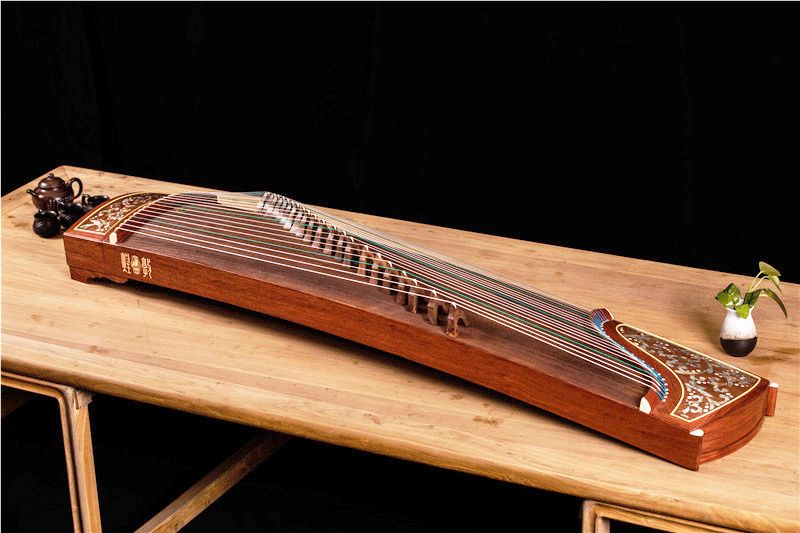The Origin and Development History of Guzheng
2009 views · Organized by 山霁 on 2022-02-07
As early as the Warring States Period from the 5th century BC to the 3rd century BC, the guzheng was widely circulated in the Qin state (now Shaanxi). The origin of the guzheng is still inconclusive. Due to historical changes and regional influences, local styles and playing techniques have been different, and thus various different guzheng schools have been formed today, making the development of guzheng more and more prosperous.

Before the Han and Jin Dynasties, the zheng had twelve strings (see "There are twelve strings" in Wei Ruan Li's "Waizheng Fu").
During the Sui and Tang Dynasties, the zheng was increased from twelve strings to thirteen strings (see Tang Cen Shen's "Qin Zheng Song, Sending Nephew Xiao Zheng Back to Beijing" "If you don't hear the Qin Zheng sound, it is the most bitter, and the five-color strings are wrapped around thirteen columns").
After the Ming and Qing dynasties, it gradually increased to fifteen strings. The "Da Qing Hui Dian" published in the Guangxu period of the Qing Dynasty recorded: "The fifteen strings of Qin Zheng are like a serenity...".
From the end of the Qing Dynasty to the beginning of the Republic of China, a new 16-string zheng appeared. This 16-string first is the traditional zheng that has been popular in China for nearly a hundred years.
After 1949, the zheng, an ancient folk musical instrument, has successfully developed an S-shaped twenty-one-string nylon-steel-wound zheng on the basis of the reform of its shape and string quality through the scrutiny and research of performers and relevant experts. Due to the enlarged resonance body and the increase of the number of strings, this kind of zheng obviously enriches the sound effect and the thickness of the pronunciation. The zheng that has been passed down through the ages is even more euphemistic and beautiful, full of charm. The S-type twenty-one-string nylon-steel-wound zither is a popular zither in China and around the world.
In the 21st century, a group of young guzheng players have emerged, including Wang Zhongshan, Zhai Zhirong, Qiu Ji, Yuan Sha, Jiang Zhoujian, Liu Le, Bao Dong, Song Xinxin and other teachers. Over the years, these performers have visited Germany, Austria, the United Kingdom, France, Italy, the Netherlands, Russia, Belgium, Switzerland, Sweden, Hungary, Poland, Japan, Singapore, Taiwan, Hong Kong and other regions and countries. Make the guzheng musical instrument to the world.
Involving musical instruments
Guzheng (pinyin: Gǔ Zhēng), also known as Hanzheng and Qinzheng, is an ancient national musical instrument of the Han nationality and is popular all over China. It is often used for solo, duet, instrumental ensemble and accompaniment of song and dance, opera and folk art. Because of its wide range, beautiful timbre, rich playing skills and strong expressiveness, it is known as the "King of Music", also known as "Oriental Piano", and is one of the unique and important national musical instruments in China.
Guess you like
Organized by 风月呢喃 on 2024-09-20
In traditional Chinese music, Guzheng is popular for its unique timbre and rich expression. As a classic guzheng song, "Jasmine Fragrance" not only shows the charm of the guzheng, but also integrates the elegance and fragrance of jasmine into the melody, giving people the enjoyment of beauty and spiritual comfort.
read >>
Organized by 未知领地 on 2024-09-01
Yue Er Gao is a classic piece of traditional Chinese music, which not only occupies a place in the repertoire of Guzheng, but also one of the repertoire often played by many other ethnic instruments.
read >>
Organized by 长乐 on 2024-08-31
In the vast ocean of Chinese traditional music, "Han Jiang Yun" is like a bright pearl, attracting countless listeners with its unique artistic charm. This kite song is not only light and lively, but also the emotions of the performer and the imagination of the listener are closely linked, weaving together a vivid picture.
read >>
Organized by 年糕 on 2024-08-29
In the treasure house of Chinese traditional music, "Waves Rushing Sand" is famous for its unique charm and profound cultural heritage. This work not only shows the unique charm of Guzheng, a national musical instrument, but also carries rich historical stories and cultural connotations.
read >>
Organized by 湛鹰 on 2024-08-26
From August 21 to 24, 2024, the National Final of "Dunhuang Star" Youth Guzheng Art Exhibition was successfully held in Mingqiang Primary School, Qibao Town, Minhang District, Shanghai.
read >>
Hot news
- 01 The legend of Matouqin
- 02 Echoes of history and artistic narration of music: In-depth analysis and cultural connotation exploration of the famous Pipa song "House of Flying Faces"
- 03 Sunset Flute and Drum - A Deep Interpretation of the Poetic and Artistic Conception and Music Narration in Ancient Pipa Songs
- 04 The difference between cymbals and cymbals in ethnic musical instruments
- 05 Pipa famous song "Overlord Unarmor" : historical picture and heroic lament in music
 渝公网安备 50010702504639号
渝公网安备 50010702504639号